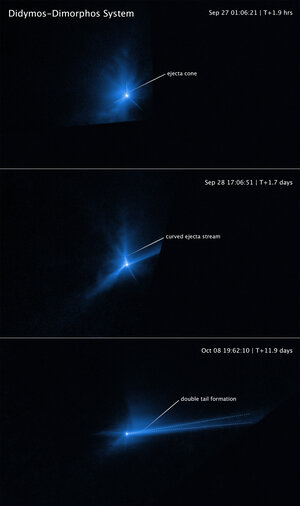Hubble’s resulting time-lapse movie of the aftermath of the collision reveals surprising and remarkable changes as dust and chunks of debris were flung into space from the wounded asteroid. Smashing head-on into the asteroid at 21 000 kilometres per hour, the DART impactor blasted over 900 000 kilograms of dust off of the asteroid.
The Hubble movie provides invaluable new clues into how the debris was dispersed into a complex pattern in the days following the impact.
The movie shows three overlapping stages of the aftermath of the crash: the formation of an ejecta cone, the spiral swirl of debris caught up along the asteroid’s orbit about its companion asteroid, and the tail swept behind the asteroid by the pressure of sunlight.
The Hubble movie starts at 1.3 hours before impact. In this view both Didymos and Dimorphos are within the central bright spot; even Hubble can’t resolve the two asteroids separately. The thin, straight spikes projecting away from the centre (and seen in later images) are artefacts of Hubble’s optics. The first post-impact snapshot is two hours after the event. Debris flies away from the asteroid, moving in with a range of speeds faster than four miles per hour (fast enough to escape the asteroid’s gravitational pull, so it does not fall back onto the asteroid). The ejecta forms a largely hollow cone with long, stringy filaments.
At about 17 hours after the collision the debris pattern entered a second stage. The dynamic interaction within the binary system started to distort the cone shape of the ejecta pattern. The most prominent structures are rotating, pinwheel-shaped features. The pinwheel is tied to the gravitational pull of the companion asteroid, Didymos.
Hubble next captures the debris being swept back into a comet-like tail by the pressure of sunlight on the tiny dust particles. This stretches out into a debris train where the lightest particles travel the fastest and farthest from the asteroid. Hubble also recorded the tail splitting in two for a few days.



